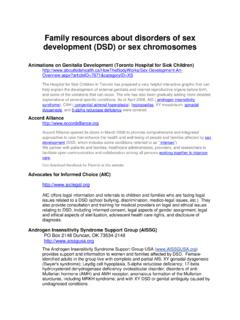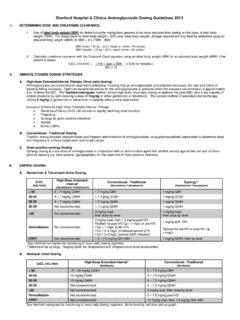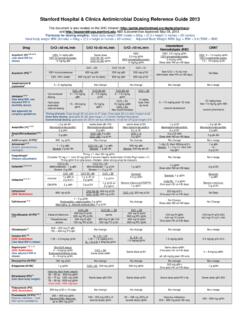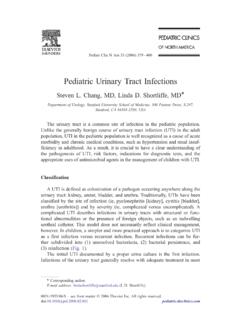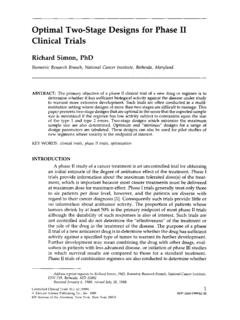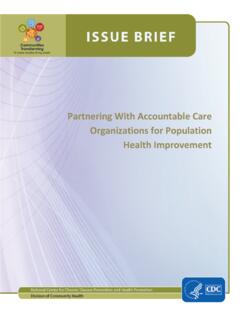Transcription of PHASE I/II CLINICAL TRIAL DESIGN AND DOSE FINDING …
1 5/5/201711 PHASE I/II CLINICAL TRIAL DESIGN AND dose FINDING (PART I)(CHAPTER 1, 7)NAITEE TING, BOEHRINGER-INGELHEIM2 DRUG development PROCESSDrug DiscoveryNon- CLINICAL DevelopmentClinical development PHASE IClinical pharmacology (PK/PD, MTD) PHASE II Drug efficacy/safety, dose ranging PHASE III Long-term, large scale, confirmatory PHASE IV Post-market5/5/20172 PHASE I CLINICAL TRIALS NON LIFE-THREATENING DISEASESH ealthy normal volunteersPrimarily for PK propertiesHelp recommend dosing frequencyEstimate maximally tolerated dose (MTD) dose escalation DESIGN or crossover designs are popular in PHASE I34 CONCERNS IN DEVELOPING DRUGS FOR LIFE-THREATENING DISEASESMay not be ethical to use placebo controlMay not be ethical to recruit normal healthy volunteersOpen label, single arm, dose escalation study designs5/5/201735 dose - FINDING IN ONCOLOGYC ancer patients in PHASE INot ethical for placebo controlDose limiting toxicity (DLT)
2 P[toxicity at MTD] = Where is the target probability of toxicity6 dose - FINDING IN ONCOLOGYTRADITIONAL 3+3 DESIGN The most widely used DESIGN in oncologySubjects are assigned in groups of 3If only 3 subjects on the current dose , then no toxicity -> 3 on next higher dose one toxicity -> add 3 on the same dose two or more toxicity -> MTD is exceeded5/5/201747 dose - FINDING IN ONCOLOGYTRADITIONAL 3+3 DESIGNIf 6 patients on the same dose , then: If at most one toxicity -> 3 on next higher dose If two or more toxicities -> MTD exceededThe estimated MTD is the highest dose level with observed toxicity rate less than II CLINICAL TRIALSF irst PHASE II is Proof of Concept (PoC)Followed by dose -ranging trialsObjective is to propose dose (s) for PHASE III designMoving doses down to MinEDIf dose -range is not found in PHASE II, it will be too expensive in later Phases85/5/201759 PROOF OF CONCEPT (POC) STUDY Typically two treatment groups Parallel DESIGN Placebo controlled Use a dose at MTD or close to MTD Short term, CLINICAL efficacy endpoint (surrogate markers may be used at times)
3 Moderate sample sizeSAMPLE SIZE FOR A POC DESIGNP eople come to statistician asking for sample sizeThis is the opportunity for a statistician to contribute to the study designAssuming is positiveAssuming variance = 1N is calculated given and 105/5/20176 PROOF OF CONCEPTH ypothesis testingPrimary endpoint is CLINICAL efficacyPre-specified two-sided alpha could be >= may be greater than 80%Go/No Go decision11 PROPOSE A TOOL TO HELP WITH COMMUNICATIONSA communication tool is proposed to help the team members in understanding the risksDiscussions should happen before breaking blindAfter the DESIGN is finalizedClear Go/No Go criteria can be documented125/5/2017713 STATISTICAL HYPOTHESISH0: T Pvs H1.
4 T> Pis tested at Type I error _____|_____|_____|_____0 z (= z + z ) The distance between z and reflect the absolute value of z Hence = z + z 145/5/20178 DECISION PROCESS15 DECISION PROCESS165/5/2017917 dose RANGING STUDY Parallel dose groups Placebo controlled Duration of treatment limited by animal tox coverage Many doses of test drug Objective is to explore a range of efficacious dosesMINIMUM EFFECTIVE dose (MINED)Imagine the difficulty in a PoC studyIt was MTD in PoCFrom a dose ranging DESIGN , there are multiple test dosesWhen each dose is compared with placebo, there is a PoC discussionWhich dose is efficacious? And the minimal dose ?
5 185/5/201710 WHAT IS dose RANGE?Suppose study A is designed with placebo, 20 mg, 40 mg, and 80 mgStudy B with placebo, mg, 1 mg, and 10 mgWhich DESIGN has a wider range?19 WHAT IS dose RANGE? dose range for a given study is defined as the high dose divided by the low dose in the designDesign A has a dose range of 4 DESIGN B has a dose range of 100205/5/20171121 CONCERNS IN dose RANGING STUDIES Number of doses to be tested Need an active control? dose spacing Choice of endpoints Length of study22 WHY POC AND dose RANGING SEPARATE? Not sure if test drug works Formulation ( dose strength) limitations Extrapolation from PD endpoints to CLINICAL efficacy endpoints Investment/cost Possible ethical concerns5/5/201712 IMPACT OF POC DECISIONSDrug formulationOrdering large quantity of raw materials?
6 Long term toxicity studies?Clear Go/No Go decision very criticalAvoid inconclusiveness23 RISKS OF INCONCLUSIVENESSC linical TRIAL process: DESIGN -> conduct -> unblind -> results ?? Decision ??To go? Or not to go? is the questionThis decision has to be madeDelay in this decision impact formulation, order of raw materials, and tox studiesInconclusiveness happens between study results and decision245/5/201713 RISKS OF INCONCLUSIVENESSA fter results are ready, there is very little a statistician can doThe critical time for statisticians to help the team is at the DESIGN stageClearly communicate the Type I and II risksDefine Go/No Go criteria25265/5/201714 INDIVIDUAL dose RESPONSE AND POPULATION dose RESPONSE27285/5/2017152930 DRUG LABEL (PACKAGE INSERT)
7 Summary Information of the Drug Agreed with Regulatory Agencies Target Product Profile Competitors on Market Easy for Physicians to prescribe5/5/20171631 Pre-clinicalPhaseIPhaseIIPhaseIIIDrugLab elForward: Accumulating informationBackward: Planning Based on LabelPLANNING PROCESSC hapter 132 WHAT ARE THE ISSUES IN dose FINDING ? Individual versus global responses What are you looking for? What range of doses should we consider? How many doses to be tested? What are we measuring? The differences in exploration and confirmation5/5/20171733 INDIVIDUAL VERSUS GLOBAL RESPONSES In most of drugs, we need to recommend a few fixed doses For wide Therapeutic Index (TI), it is possible to use one dose dose response relationship vs concentration response relationship34 PHARMACOKINETICS (PK), PHARMACODYNAMICS (PD) PK, PD, PK/PD PK: body act on drug PD: drug act on body Concentration response uses PK, but should we consider PD?
8 5/5/20171835 DETERMINING DOSING FREQUENCYDETERMINING DOSING FREQUENCY When determining dosing frequency, the pharmacodynamics of a compound should be considered as critical as the pharmacokinetics In contrast to the pharmacokinetic half-life, the pharmacodynamic half-life will be dose dependent Will a control release formulation be needed?36Q day dosing at 2x doseBid Dosing at 1x doseMinimal effective levelby PD marker12h 24hDrug ConcentrationQD Feasible if high levels are well tolerated, otherwisewill need to default to BID dosing or change shapeof curve with DOSING FREQUENCY5/5/20171937IS THERE A dose RESPONSE?05101520253035 LowMediumHighSeries138 IMPORTANCE OF PLACEBO RESPONSE05101520253035 PlaceboLowMediumHighSeries15/5/20172039 ACTIVE CONTROL0102030405060 PlaceboLowMediumHighActiveSeries140 ACTIVE CONTROL05101520253035 PlaceboLowMediumHighActiveSeries15/5/201 72141 ACTIVE CONTROL Active control is not strictly necessary It serves as a useful control in case the test drug doesn t work or works poorly Active control worked or not?
9 An active comparator may also be critical if there is an effective competitor on the market How appropriate are PHASE II comparisons? Statistically valid vs looks similar ?42 DRUG ASTUDY 1 - WHAT S NEXT?-25-20-15-10-50 Placebo80 mg120 mg160 mgSeries15/5/20172243 DRUG ASTUDY 2 - WHAT S NEXT?-25-20-15-10-50 Placebo 40 mg80 mg 120 mgSeries144 DRUG AAfter study 2, the PHASE III study started with dose 120 mgAt end of PHASE II meeting, FDA questioned about doseWe designed the third dose FINDING study to look at doses mg, 10 mg and 40 mg5/5/20172345 DRUG A - STUDY mg10 mg40 mgSeries146 DRUG ARedesigned PHASE III studies with 20 mg and 40 mgIt took 3 studies to find the efficacy dose responseThe large scale study with 120 mg cannot be used for registrationFiling was delayed by many years5/5/2017244748 MULTIPLE-ARM dose -RESPONSE TRIALM onotonic dose -response relationship is very common in groups are not sufficient to characterize the nonlinear nature of TRIAL is specially informative for drug with a wide therapeutic window.
10 5/5/20172549 WHAT RANGE OF DOSES SHOULD WE CONSIDER In early PHASE II, not much information available (pre- CLINICAL , PK, MTD) We know 0 (Placebo), we know MTD Exploring an Adequate dose Range Selecting Doses for Early dose -ranging Studies 50 WHAT RANGE OF DOSES SHOULD WE CONSIDERWHAT RANGE OF DOSES SHOULD WE CONSIDER Examine a wide dose range in early development and follow this study with a narrower dose range study Use pharmacological response or biological markers from animal studies and PHASE I studies to guide the selection in dose range for the early studies Although not always attainable in early studies, a goal should be to try and define the Maximally Tolerated dose (MTD), the Maximally Effective dose (MaxED), and the Minimum Effective dose (MinED)
